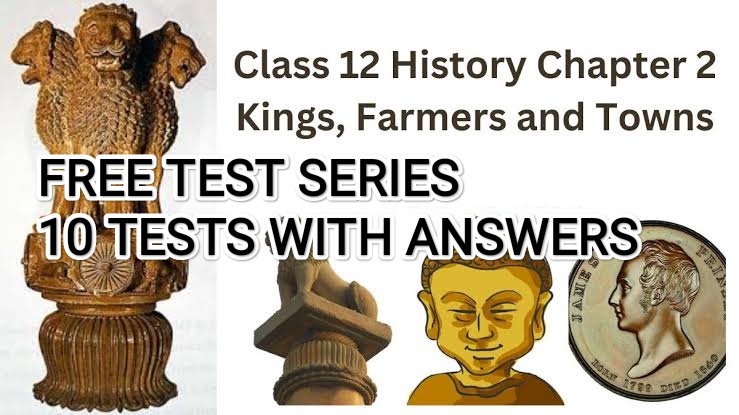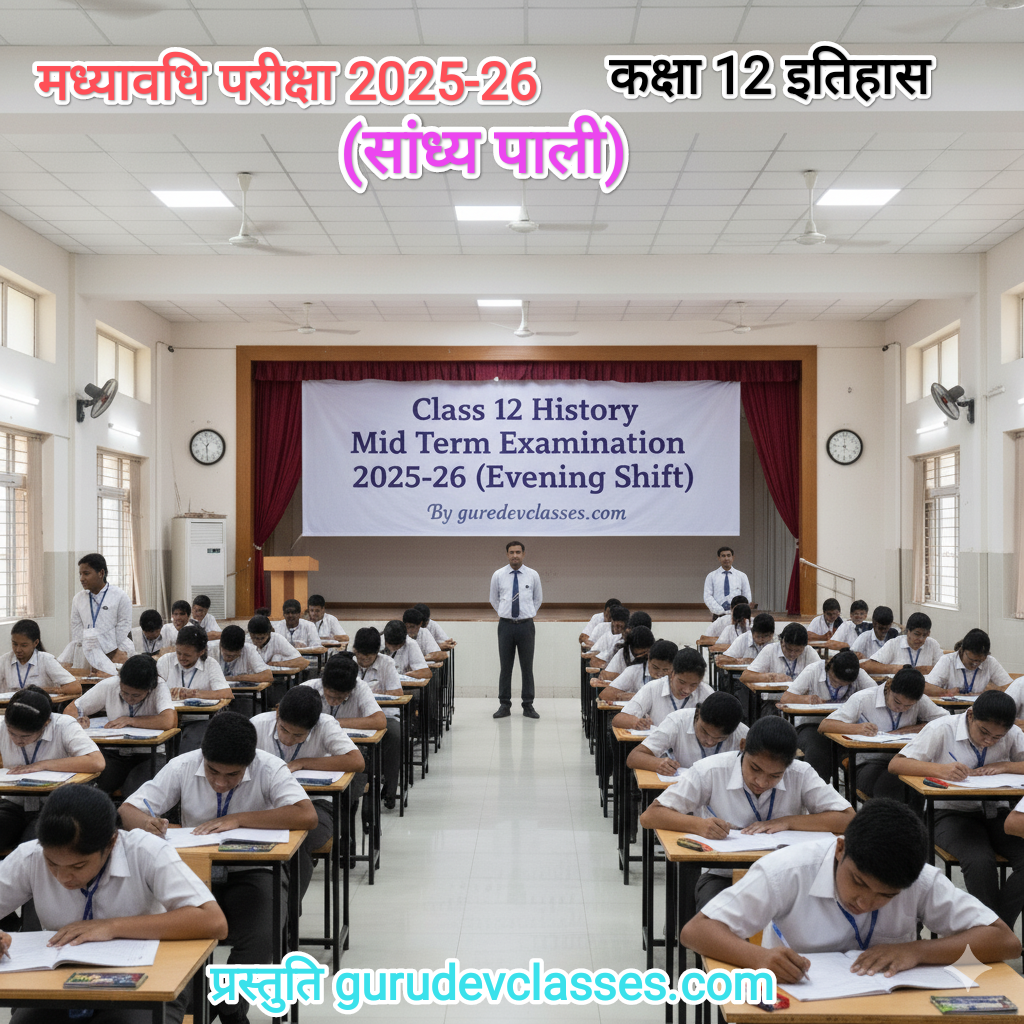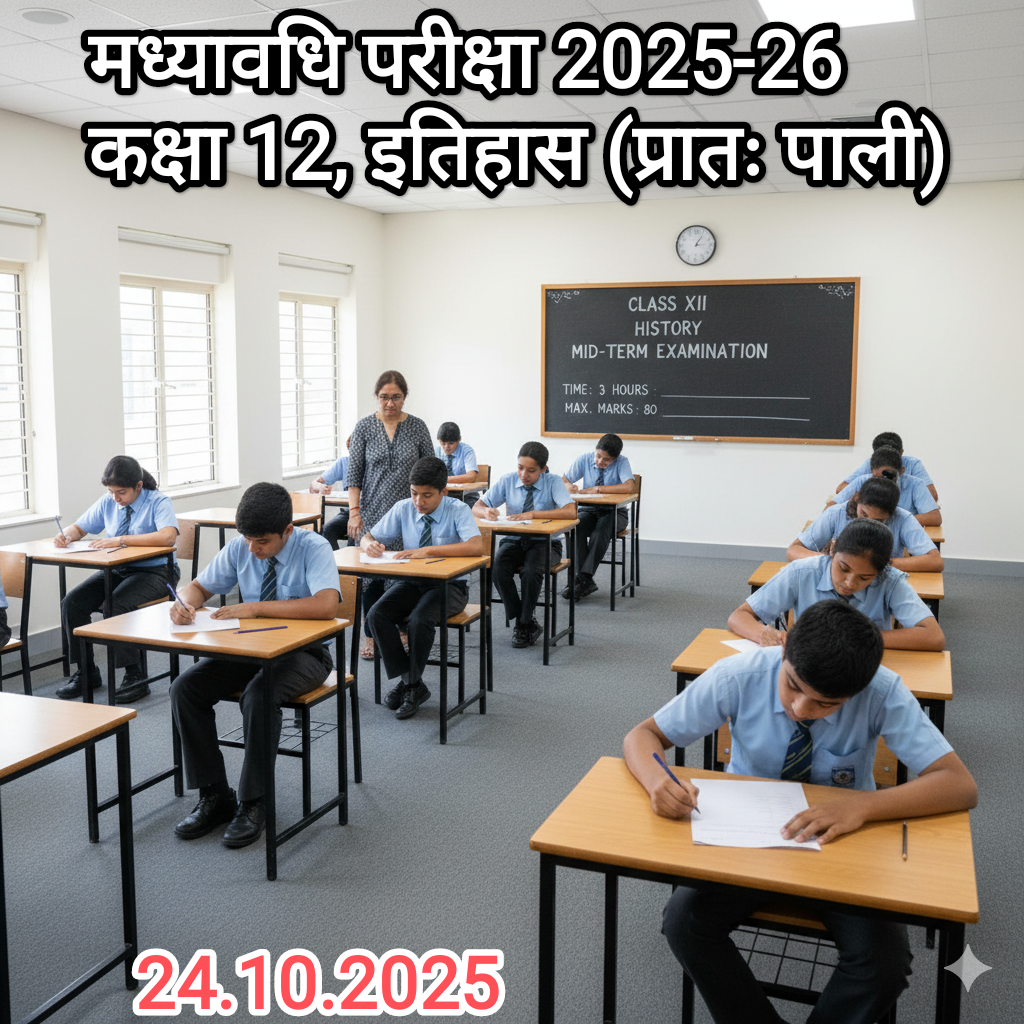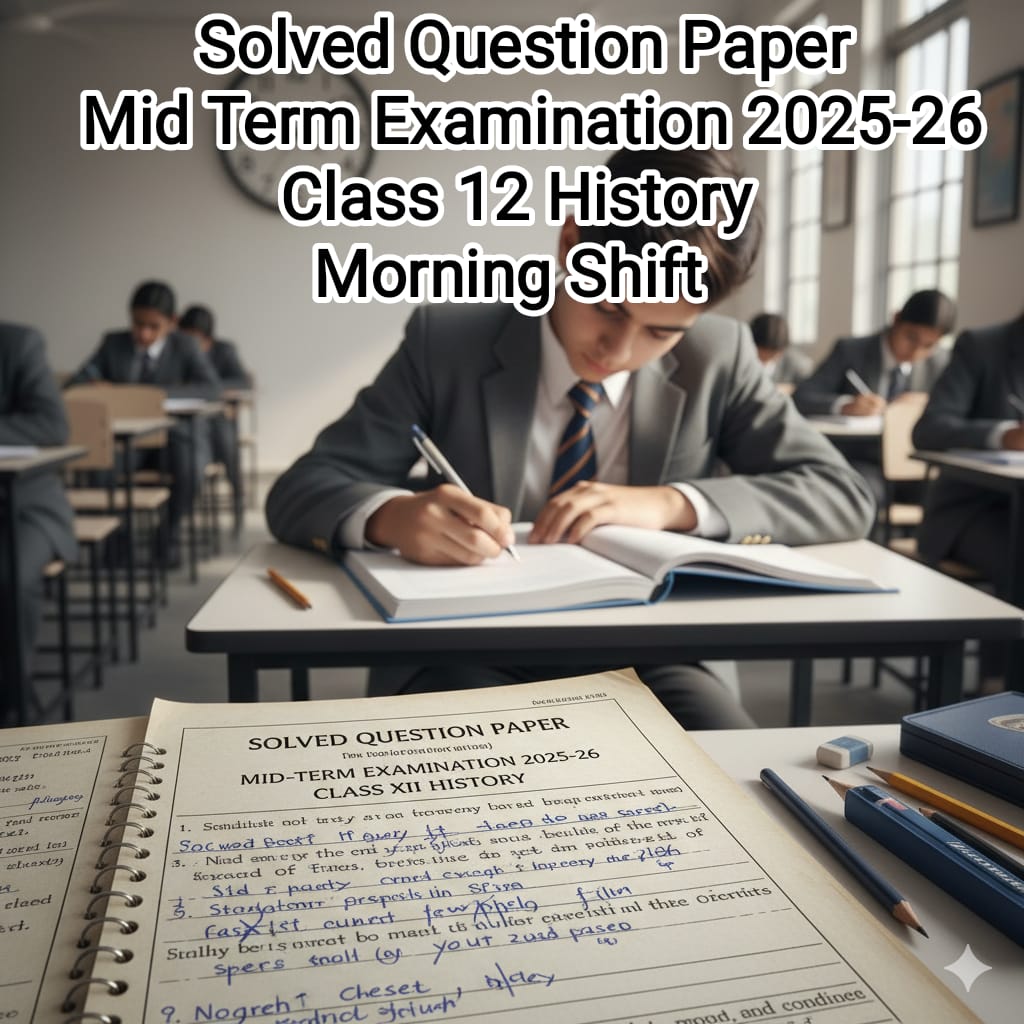Free Class 12 History Test Series for CBSE Board 2025 – Chapter-wise practice papers with detailed answer keys, MCQs, source-based questions, and 5-mark answers. Covers Breaks, Beads & Bones and Kings, Farmers & Towns without question repetition. Perfect for Board Exam preparation.
Test 1 – Question Paper
Section A – MCQ (1×5 = 5 marks)
- Which ruler is known for the Ashokan inscriptions?
a) Chandragupta Maurya
b) Ashoka
c) Harshavardhana
d) Samudragupta - The Hathigumpha inscription is associated with which ruler?
a) Ashoka
b) Kharavela
c) Pulakeshin II
d) Rudradaman - Who composed the “Prayaga Prashasti”?
a) Kalidasa
b) Harisena
c) Banabhatta
d) Megasthenes - Which ancient text is a treatise on statecraft attributed to Kautilya?
a) Manusmriti
b) Arthashastra
c) Mahabharata
d) Indica - The Junagadh inscription of Rudradaman describes the repair of which lake?
a) Dal Lake
b) Sudarshana Lake
c) Pushkar Lake
d) Sambhar Lake
Section B – 2 marks each (2×2 = 4 marks)
- Name any two sources that provide information about the Mauryan Empire.
- Source-based question:
“King Ashoka declares that he considers the welfare of all beings as his duty, and that he wishes to promote Dhamma by moral example rather than by force. He instructs officers to tour the empire and report to him regularly.”
Questions:
(a) Which type of inscription is this?
(b) What does this reveal about Ashoka’s administrative policy?
Section C – 3 marks each (3×2 = 6 marks)
- Mention three features of Ashokan inscriptions.
- Write three features of the economic life during the Mauryan period.
Section D – 5 marks (1×5 = 5 marks)
- Describe any eight features of the administration of the Mauryan Empire.
Test 2 – Question Paper
Section A – MCQ (1×5 = 5 marks)
- The Harshacharita was composed by:
a) Kalhana
b) Banabhatta
c) Kalidasa
d) Harisena - The title “Maharajadhiraja” means:
a) Great King of Kings
b) Protector of Dharma
c) Lord of the World
d) Chief of Army - Which inscription provides information about the military achievements of Samudragupta?
a) Junagadh inscription
b) Allahabad pillar inscription
c) Hathigumpha inscription
d) Maski inscription - Megasthenes visited the court of which Mauryan ruler?
a) Ashoka
b) Bindusara
c) Chandragupta Maurya
d) Samudragupta - The term “Gahapati” in early India referred to:
a) Village headman
b) Head of a household
c) Chief priest
d) Tax collector
Section B – 2 marks each (2×2 = 4 marks)
6. Name any two types of coins used during the Mauryan period.
7. Source-based question:
“Samudragupta, whose body was most charming and covered with natural marks of glory, was a man whose mind was set upon the conquest of the whole world. He was compassionate to those who sought his shelter and destroyed all his enemies.”
Questions:
(a) From which inscription is this excerpt taken?
(b) Name any one quality of Samudragupta mentioned here.
Section C – 3 marks each (3×2 = 6 marks)
8. Write three important features of the Gupta administration.
9. Mention three functions of the village headman in early India.
Section D – 5 marks (1×5 = 5 marks)
10. Describe any eight features of the land revenue system during the Mauryan period.
Test 3 – Question Paper
Section A – MCQ (1×5 = 5 marks)
- Which ancient text is a Buddhist chronicle of Sri Lanka?
a) Dipavamsa
b) Arthashastra
c) Harshacharita
d) Indica - The term “Janapada” refers to:
a) Capital city
b) Territorial unit/kingdom
c) Religious center
d) Royal palace - The Prakrit language was used in Ashokan inscriptions mainly because:
a) It was the court language
b) It was the language of the common people
c) It was used by priests only
d) It was easy to carve - Which ruler performed the Ashvamedha sacrifice to assert his power?
a) Ashoka
b) Samudragupta
c) Harshavardhana
d) Kharavela - Who wrote the “Indica”?
a) Ashoka
b) Megasthenes
c) Fa-Hien
d) Kautilya
Section B – 2 marks each (2×2 = 4 marks)
6. Mention any two duties of a Mauryan officer called “Rajuka”.
7. Source-based question:
“This edict has been written so that it may endure as long as my sons and grandsons live; and in accordance with it they may act for the welfare of the world. But it is difficult to act without great effort, and it is only by great effort that happiness is won.”
Questions:
(a) Who issued this edict?
(b) What is its central message?
Section C – 3 marks each (3×2 = 6 marks)
8. State three features of trade and commerce during the Mauryan period.
9. Describe three methods used by rulers to proclaim their achievements in ancient India.
Section D – 5 marks (1×5 = 5 marks)
10. Explain any eight features of the Ashvamedha sacrifice.
Test 4 – Question Paper
Section A – MCQ (1×5 = 5 marks)
- The “Sangam” literature is a source of history for:
a) Northern India
b) Deccan region
c) Southern India
d) Western India - The Sanchi Stupa was built during the reign of:
a) Ashoka
b) Chandragupta Maurya
c) Samudragupta
d) Harshavardhana - Inscriptions were generally composed in which scripts during the Mauryan period?
a) Brahmi and Kharosthi
b) Devanagari and Tamil
c) Pali and Sanskrit
d) Sharada and Modi - The Hathigumpha inscription is located in:
a) Odisha
b) Bihar
c) Madhya Pradesh
d) Gujarat - Which ruler is associated with the repair of Sudarshana Lake?
a) Kharavela
b) Rudradaman
c) Harshavardhana
d) Samudragupta
Section B – 2 marks each (2×2 = 4 marks)
6. Name any two archaeological sources of the Mauryan period.
7. Source-based question:
“We bow to thee, the mother of all beings, to the one who nourishes all. O Earth, you are the abode of treasures, please grant us prosperity and long life.”
Questions:
(a) Which ancient practice does this verse reflect?
(b) What does it reveal about the people’s relationship with nature?
Section C – 3 marks each (3×2 = 6 marks)
8. Mention three features of urban centers in the Mauryan Empire.
9. State any three reasons for the use of inscriptions by ancient rulers.
Section D – 5 marks (1×5 = 5 marks)
10. Explain eight features of the economic life during the Gupta period.
Test 5 – Question Paper
Section A – MCQ (1×5 = 5 marks)
- The Allahabad Pillar inscription was composed by:
a) Harisena
b) Banabhatta
c) Kalidasa
d) Megasthenes - Which term was used for tax-free land grants in ancient India?
a) Agrahara
b) Visti
c) Bali
d) Bhaga - Which ancient work describes Chandragupta Maurya’s court in detail?
a) Arthashastra
b) Indica
c) Harshacharita
d) Sangam literature - The term “Kumaramatya” in the Gupta administration referred to:
a) Royal priest
b) Chief minister
c) Provincial governor
d) Village officer - Which inscription records the achievements of Kharavela?
a) Junagadh inscription
b) Hathigumpha inscription
c) Allahabad pillar inscription
d) Mehrauli inscription
Section B – 2 marks each (2×2 = 4 marks)
6. Name any two titles adopted by Gupta rulers.
7. Source-based question:
“The king is the guardian of varnas and ashramas, and is responsible for the protection of his subjects. He must act in accordance with dharma, and punish those who violate it.”
Questions:
(a) Which text might contain such an instruction?
(b) What is the role of the king according to this view?
Section C – 3 marks each (3×2 = 6 marks)
8. Mention three features of coinage during the Gupta period.
9. State three important functions of the Mauryan spies.
Section D – 5 marks (1×5 = 5 marks)
10. Describe eight features of the Mauryan judicial system.
Test 6 – Question Paper
Section A – MCQ (1×5 = 5 marks)
- Which Mauryan official was responsible for forests?
a) Amatyas
b) Dhamma Mahamatta
c) Vanapala
d) Rajuka - Who was the author of Mudrarakshasa?
a) Vishakhadatta
b) Kalidasa
c) Bana
d) Harisena - Which river is mentioned in the Prayaga Prashasti?
a) Ganga
b) Yamuna
c) Saraswati
d) Narmada - What was the main source of revenue in the Mauryan Empire?
a) Trade tax
b) Land revenue
c) Salt tax
d) Custom duties - Who was the founder of the Shunga dynasty?
a) Pushyamitra Shunga
b) Agnimitra
c) Vasumitra
d) Devabhuti
Section B – 2 marks each (2×2 = 4 marks)
6. Name two forms of land grants in ancient India.
7. Source-based:
“King Ashoka orders that medical facilities for both humans and animals be established in his empire, and useful medicinal herbs be imported and planted wherever not found.”
(a) What does this inscription show about Ashoka’s policies?
(b) Which value of Ashoka is reflected here?
Section C – 3 marks each (3×2 = 6 marks)
8. Mention three features of the post-Mauryan political structure.
9. Explain three functions of the Mauryan provincial administration.
Section D – 5 marks (1×5 = 5 marks)
10. Describe eight main features of the urban centres of the Mauryan period.
Test 7 – Question Paper
Section A – MCQ
- Which title did Samudragupta assume after his conquests?
a) Maharajadhiraja
b) Vikramaditya
c) Parameshwara
d) Chakravartin - Who was the Greek ambassador in the court of Chandragupta Maurya?
a) Ptolemy
b) Pliny
c) Megasthenes
d) Herodotus - Which of the following is a Buddhist text?
a) Manusmriti
b) Dipavamsa
c) Arthashastra
d) Harshacharita - In which script were Ashokan inscriptions in the northwest written?
a) Brahmi
b) Kharosthi
c) Tamil-Brahmi
d) Gupta script - Which ruler performed the Ashvamedha sacrifice during Gupta rule?
a) Chandragupta I
b) Samudragupta
c) Chandragupta II
d) Kumaragupta
Section B – 2 marks each
6. Mention two measures taken by rulers to control trade.
7. Source-based:
“This king of kings is compassionate and victorious. His conquests bring not only wealth but also the establishment of just governance.”
(a) Which ruler could this refer to?
(b) Which quality is being praised?
Section C – 3 marks each
8. Mention three duties of the Mauryan spies.
9. Give three differences between punch-marked coins and Gupta coins.
Section D – 5 marks
10. Explain eight main features of the Mauryan administrative system.
Test 8 – Question Paper
Section A – MCQ
- Which ruler is known for the Hathigumpha inscription?
a) Kharavela
b) Ashoka
c) Rudradaman
d) Pulakeshin II - Which was the main medium of instruction in ancient gurukuls?
a) Pali
b) Prakrit
c) Sanskrit
d) Tamil - Which road connected Pataliputra to the northwestern region?
a) Uttarapatha
b) Dakshinapatha
c) Rajpath
d) Mahamarg - Who composed the Harshacharita?
a) Bana
b) Harisena
c) Vishakhadatta
d) Kalhana - The Junagadh inscription records the repair of which lake?
a) Pushkar Lake
b) Sudarshana Lake
c) Man Sagar Lake
d) Dal Lake
Section B – 2 marks each
6. Name two important features of the Arthashastra.
7. Source-based:
“Rivers are the lifelines of the kingdom. The state will build embankments and canals for irrigation.”
(a) Which period does this policy resemble?
(b) What does this show about the ruler’s priorities?
Section C – 3 marks each
8. Write three features of land grants during Gupta period.
9. Mention three features of Mauryan taxation policy.
Section D – 5 marks
10. Describe eight main features of the Mauryan trade network.
Test 9 – Question Paper
Section A – MCQ
- Which ruler repaired the Sudarshana Lake?
a) Ashoka
b) Rudradaman
c) Kharavela
d) Samudragupta - The term Agrahara refers to:
a) Fort
b) Tax-free land grant to Brahmanas
c) Market place
d) Royal palace - Which script was used in Ashokan inscriptions in the south?
a) Brahmi
b) Tamil-Brahmi
c) Kharosthi
d) Grantha - Who was the court poet of Samudragupta?
a) Harisena
b) Bana
c) Vishakhadatta
d) Kalidasa - Which was the capital of the Mauryan Empire?
a) Ujjain
b) Taxila
c) Pataliputra
d) Prayaga
Section B – 2 marks each
6. Name any two ancient ports in India.
7. Source-based:
“Let the king be ever active in the management of the economy, for the root of wealth is economic activity, and inactivity brings ruin.”
(a) Name the text this is from.
(b) What does this line stress?
Section C – 3 marks each
8. State three causes for the rise of urban centres in the Mauryan Empire.
9. Mention three important features of the Gupta coinage.
Section D – 5 marks
10. Explain eight features of the Mauryan military organisation.
Test 10 – Question Paper
Section A – MCQ
- Which Mauryan ruler sent missions to Sri Lanka?
a) Bindusara
b) Ashoka
c) Chandragupta
d) Dasharatha - The Prayaga Prashasti was written in:
a) Prakrit
b) Sanskrit
c) Pali
d) Tamil - Who wrote Indica?
a) Ptolemy
b) Pliny
c) Megasthenes
d) Arrian - What was the chief occupation of people during Mauryan period?
a) Craft production
b) Agriculture
c) Trade
d) Hunting - Which title was used by the Gupta kings?
a) Devanampriya
b) Paramabhattaraka
c) Chakravartin
d) Maharana
Section B – 2 marks each
6. Name two officials mentioned in the Arthashastra.
7. Source-based:
“King Ashoka declares: All men are my children. Just as I wish my own children to be happy in this world and the next, so do I wish the same for all.”
(a) What does this reveal about Ashoka’s view of his subjects?
(b) Which value of governance is reflected here?
Section C – 3 marks each
8. Mention three measures taken by Ashoka to spread Dhamma.
9. Describe three functions of Mauryan public works department.
Section D – 5 marks
10. Explain eight features of the provincial administration of the Mauryan Empire.
Alright — I’ll give you the full point-wise answer keys for Chapter 2: Kings, Farmers and Towns covering Test 1 to Test 10 in one go so you can save it easily.
Test 1 – Answer Key
MCQs
- b) Ashoka
- b) Kharavela
- b) Harisena
- b) Arthashastra
- b) Sudarshana Lake
Q6. Two sources on Mauryan Empire
- Arthashastra by Kautilya.
- Ashokan inscriptions.
Q7. Source-based
- Type: Edict (Pillar inscription).
- Meaning: Shows Ashoka’s emphasis on moral governance (Dhamma) over force, with administrative officers ensuring welfare.
Q8. Features of Ashokan inscriptions
- Written in Prakrit, Brahmi script in most regions.
- Engraved on rocks and pillars.
- Spread across vast empire to reach different populations.
Q9. Economic life in Mauryan period
- State control over agriculture and irrigation.
- Widespread craft production and trade.
- Tax collection in cash and kind.
Q10. Administration of Mauryan Empire (8 points)
- King was supreme authority.
- Empire divided into provinces.
- Provincial governors managed administration.
- District officers supervised revenue and law.
- Village headmen handled local issues.
- Spy system for intelligence.
- Regulated weights, measures, and markets.
- Welfare works like roads and hospitals.
Test 2 – Answer Key
MCQs
- c) Brahmi and Kharosthi
- b) Rudradaman I
- a) Hathigumpha inscription
- c) Megasthenes
- a) Prayaga Prashasti
Q6. Two languages of early inscriptions
- Prakrit.
- Sanskrit.
Q7. Source-based
- Source: Junagadh inscription of Rudradaman.
- Content: Mentions repair of Sudarshana Lake after Mauryan period; shows continuation of public works and importance of irrigation.
Q8. Features of Prayaga Prashasti
- Composed by Harisena, court poet of Samudragupta.
- Lists military victories and political control.
- Uses ornate Sanskrit language to glorify ruler.
Q9. Features of craft production in early historic cities
- Specialised production of beads, textiles, metalwork.
- Guilds regulating quality and trade.
- Export of luxury goods to foreign markets.
Q10. Ashvamedha sacrifice (8 points)
- Royal horse let loose to wander.
- Territories it entered had to accept sovereignty or fight.
- Performed to assert political supremacy.
- Followed by elaborate rituals.
- Brahmanas conducted sacrifices.
- Gave prestige to ruler.
- Recorded in inscriptions and texts.
- Linked with expansionist policies.
Test 3 – Answer Key
MCQs
- a) Kautilya
- c) Tamil Brahmi
- b) Harshavardhana
- c) Nagarjunakonda
- d) Periplus of the Erythraean Sea
Q6. Two archaeological sites of early cities
- Pataliputra.
- Ujjain.
Q7. Source-based
- Source: Periplus of the Erythraean Sea.
- Content: Greek account of Indian ports, trade routes, goods; shows India’s participation in Indian Ocean trade.
Q8. Features of urban centres in the early historic period
- Fortified structures.
- Planned streets and drains.
- Public buildings like assembly halls.
Q9. Role of inscriptions in political history
- Document conquests and dynastic lineage.
- Reveal administrative arrangements.
- Record royal titles and ideologies.
Q10. Guilds in ancient India (8 points)
- Organisation of artisans/merchants.
- Regulated quality of goods.
- Fixed prices.
- Provided training to members.
- Acted as banks, lending money.
- Maintained internal discipline.
- Represented members before rulers.
- Played role in civic works and donations.
Test 4 – Answer Key
MCQs
- b) Gupta
- a) Skandagupta
- d) Amaravati
- c) Banabhatta
- b) Mathura
Q6. Two sources of Gupta history
- Allahabad Pillar inscription.
- Coins of Gupta kings.
Q7. Source-based
- Source: Harshacharita by Banabhatta.
- Content: Biography of Harshavardhana, describes political events, social life; important literary source.
Q8. Features of Gupta coinage
- Made of gold, silver, and copper.
- Depicted kings performing rituals or hunting.
- Inscriptions in Sanskrit.
Q9. Role of agriculture in ancient economy
- Primary source of revenue for state.
- Supported urban centres and crafts.
- Provided surplus for trade.
Q10. Main features of Gupta administration (8 points)
- Decentralised governance.
- Provinces called Bhuktis.
- Districts called Vishayas.
- Village assemblies had importance.
- King at top but local officials had powers.
- Land revenue main income.
- Maintained law and justice system.
- Patronised education and religion.
Test 5 – Answer Key
MCQs
- a) Satavahanas
- b) Sangam literature
- c) Roman gold coins
- d) Bharhut
- a) Kalidasa
Q6. Two foreign accounts mentioning India
- Indica by Megasthenes.
- Writings of Fa-Hien.
Q7. Source-based
- Source: Sangam literature.
- Content: Describes Tamil society, trade, agriculture, warrior culture; valuable non-religious literary source.
Q8. Features of Satavahana rule
- Ruled Deccan region.
- Practiced land grants to Brahmanas.
- Issued bilingual inscriptions.
Q9. Role of Roman trade in India
- Import of gold and silver coins.
- Export of spices, textiles, gems.
- Boosted coastal towns.
Q10. Importance of inscriptions for social history (8 points)
- Records donations to temples.
- Shows role of women as donors.
- Mentions caste and occupational groups.
- Reveals spread of religions.
- Gives names of towns and markets.
- Shows patronage to art and architecture.
- Indicates economic prosperity.
- Records interaction between rulers and subjects.
Test 6 – Answer Key
MCQs
- b) Ashvamedha
- a) Puhar
- c) Fa-Hien
- d) Kalibangan
- a) Harisena
Q6. Two types of land grants in ancient India
- Grants to Brahmanas for religious merit.
- Grants to Buddhist monasteries for upkeep.
Q7. Source-based
- Source: Allahabad Pillar Inscription of Samudragupta.
- Content: Written by Harisena; praises Samudragupta’s military conquests, personal virtues, and generosity; shows political culture of glorifying rulers.
Q8. Features of Tamil Brahmi inscriptions
- Found mainly in caves and pottery in Tamil Nadu.
- Written in an early form of Brahmi adapted to Tamil.
- Mention donors, especially merchants and monks.
Q9. Role of Buddhist monasteries in economy
- Centres of learning and manuscript production.
- Controlled land grants and agricultural surplus.
- Served as resting places for traders.
Q10. Main features of Satavahana administration (8 points)
- Ruled Deccan between 1st century BCE–2nd century CE.
- King called ‘Rajan’ or ‘Maharaja’.
- Provinces under Amatyas (officials).
- Issued coins in lead, copper, and silver.
- Promoted trade and issued bilingual inscriptions.
- Maintained irrigation systems.
- Practiced land grants to religious institutions.
- Supported art at Amaravati and Nagarjunakonda.
Test 7 – Answer Key
MCQs
- a) Arthashastra
- b) Prashasti
- d) Junagadh inscription
- c) Samudragupta
- b) Guilds
Q6. Two officials in Mauryan administration
- Rajuka – land measurement and law enforcement.
- Yukta – revenue collection.
Q7. Source-based
- Source: Junagadh inscription of Rudradaman.
- Content: Records repair of Sudarshana Lake; highlights importance of irrigation and continuity of public works after Mauryan rule.
Q8. Features of Prashastis
- Eulogies composed in praise of kings.
- Written in ornate Sanskrit by court poets.
- Records victories, virtues, and divine legitimacy.
Q9. Role of guilds in ancient economy
- Regulated production quality.
- Controlled prices and trade.
- Acted as banks and financed works.
Q10. Mauryan economic policies (8 points)
- State ownership of land in some areas.
- Taxes on agriculture, trade, and crafts.
- Supervised irrigation and agriculture.
- Regulated weights and measures.
- Controlled mining and forestry.
- State-run workshops for weapons and goods.
- Encouraged internal and foreign trade.
- Maintained granaries for emergencies.
Test 8 – Answer Key
MCQs
- c) Megasthenes
- b) Mathura
- a) Tamil Brahmi
- d) Hathigumpha
- b) Rudradaman
Q6. Two cities of early historic north India
- Mathura.
- Pataliputra.
Q7. Source-based
- Source: Indica by Megasthenes.
- Content: Greek ambassador’s account of Mauryan India; describes administration, society, economy; though sometimes exaggerated, provides unique outsider perspective.
Q8. Features of Mathura as a city
- Religious centre for Buddhists, Jains, and Hindus.
- Hub for sculptural art and terracotta production.
- Located at crossroads of trade routes.
Q9. Role of irrigation in ancient agriculture
- Increased productivity and surplus.
- Enabled cultivation in dry areas.
- Required collective or state effort.
Q10. Role of inscriptions in reconstructing history (8 points)
- Provide names and genealogy of rulers.
- Document conquests and political boundaries.
- Record social and religious donations.
- Show economic transactions.
- Reveal administrative arrangements.
- Give dates through regnal years.
- Mention languages and scripts used.
- Indicate cultural exchanges.
Test 9 – Answer Key
MCQs
- b) Nagarjunakonda
- a) Prakrit
- c) Samudragupta
- b) Harshavardhana
- d) Amaravati
Q6. Two forms of revenue in ancient India
- Land revenue (share of produce).
- Taxes on trade and crafts.
Q7. Source-based
- Source: Harshacharita by Banabhatta.
- Content: Biography of Harshavardhana; contains details of his administration, wars, and cultural life; valuable literary source with some exaggeration.
Q8. Features of Buddhist stupas
- Built as mounds over relics of Buddha or monks.
- Circular structure with railing and gateways.
- Served as pilgrimage centres.
Q9. Role of traders in ancient economy
- Linked production centres with markets.
- Facilitated internal and overseas trade.
- Supported religious institutions through donations.
Q10. Features of Gupta economy (8 points)
- Agricultural prosperity with irrigation.
- Land grants to Brahmanas and temples.
- Active craft production (textiles, metalwork).
- Expansion of inland and maritime trade.
- Use of gold and silver coinage.
- Guilds remained active.
- Urban centres like Pataliputra thrived.
- State revenue from agriculture and trade.
Test 10 – Answer Key
MCQs
- c) Fa-Hien
- a) Arthashastra
- b) Rudradaman
- d) Kautilya
- a) Prayaga Prashasti
Q6. Two Chinese travellers who visited India
- Fa-Hien.
- Xuanzang.
Q7. Source-based
- Source: Fa-Hien’s account.
- Content: Describes Gupta India’s prosperity, mild governance, Buddhist monasteries, and social practices; confirms internal peace and flourishing economy.
Q8. Features of Arthashastra
- Written by Kautilya (Chanakya).
- Covers politics, economy, and military strategy.
- Advises on espionage, diplomacy, and taxation.
Q9. Role of religion in ancient politics
- Kings claimed divine sanction for rule.
- Performed rituals like Ashvamedha for legitimacy.
- Patronised temples and religious scholars.
Q10. Features of early historic towns (8 points)
- Fortifications for defence.
- Planned streets and drainage.
- Markets and craft workshops.
- Administrative buildings.
- Religious monuments like stupas and temples.
- Storage facilities and granaries.
- Linked to rural hinterland for supplies.
- Served as trade and cultural hubs.







